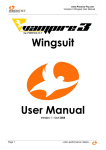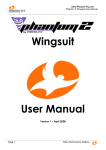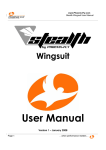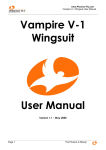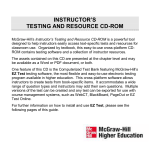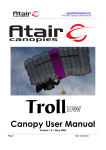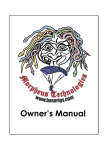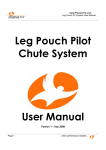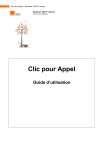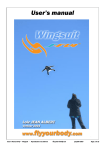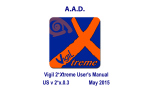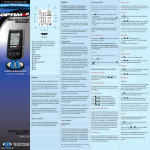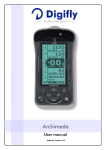Download Wingsuit User Manual
Transcript
www.Phoenix-Fly.com Prodigy 2 Wingsuit User Manual Wingsuit User Manual Version 1.0 – March 2008 Page 1 The Phoenix is Rising! www.Phoenix-Fly.com Prodigy 2 Wingsuit User Manual Disclaimer: The following information must be read and understood before any use of this equipment. The user knows the risks of skydiving and BASE jumping and accepts that: Skydiving and BASE jumping cause deaths and serious injuries. Many of these deaths and injuries can be attributed to equipment malfunctions. Skydiving equipment can fail, even if the user takes all possible precautions. Failure to open the main or reserve parachute (or to follow emergency procedures) at a safe altitude, and/or equipment failures can result in severe injury or death. It is the user‘s responsibility to: • • • • • • • Receive proper training before any use of all skydiving and BASE jumping equipment. Be extremely careful and cautious. Read and understand all owner’s and operations manuals for all skydiving equipment. Check all parachuting equipment and replace any defective or worn component prior to use. Review emergency procedures before each use of this and all parachuting equipment. Check equipment warnings - do not exceed equipment limitations. Never violate the training and experience requirements for the specific equipment in use. Because of the unavoidable dangers involved in the use of this and all parachute equipment, Phoenix Fly (including, but not limited to, all owners, officers, staff and employees) makes no warranties of any kind, expressed or implied. It is sold with all faults and without any warranty of fitness for any purpose. By using this equipment or allowing it to be used by others, owner/buyer waives any liability of Phoenix Fly for personal injuries, death or damages from such use. Any promises or representations inconsistent with, or in addition to, this statement of warranty are not authorized by Phoenix Fly and shall be not binding. If any customer of a Phoenix Fly suit declines to waive liability on the part of the manufacturer or authorized Phoenix Fly dealer, the customer may have a full refund of the purchase price by returning the suit before it is used. Return the suit to the manufacturer or authorized dealer within 21 days from the original date of purchase. Skydiving, wingsuit flying and BASE jumping are high-risk activities which may cause or result in serious injury or death. DO NOT attempt to land a wing suit without a fully inflated parachute. Page 2 The Phoenix is Rising! www.Phoenix-Fly.com Prodigy 2 Wingsuit User Manual Sections: U Pages: U 1. How to use this manual 4 2. Introducing Phoenix Fly 5 3. Features of your Prodigy 2 wingsuit 3.1: Main features of the PF Prodigy 2 wingsuit 6-9 4. Recommended Experience Level & Preparation 4.1 Recommended experience level for starting wingsuit flying 10 5. Putting on Your Prodigy 2 5.1:Taking off your wingsuit 11 – 13 6. Body Position for the Prodigy 2 14 7. Deployment Procedures 7.1: Wave-off 7.2: Pull / deployment 7.3: After the Pull / post deployment 7.4: Advanced technique 15 8. Emergency Procedures 8.1: Wing Release system 8.2: Uncontrollable Spins in Flight 8.3: Malfunction Procedure 8.4: Water Landings 16 – 17 9. Making A Flight Plan 9.1: Weather Conditions 9.2: Briefing your fellow jumpers, pilots, etc. 9.3: Flight Path 18 – 19 10. Pre-Flight Checks 10.1: Pre-Boarding checks 10.2: Prepare for flight 20 11. Maiden Flight 11.1: Practice 11.2: Equipment 11.3: Phoenix Fly suit with AADs and audible altimeters 11.4: Exits 11.5: Exercises for first flight 22 – 23 12. Taking Care of your Prodigy 2 12.1: Storing your Prodigy 2 12.2: Materials and washing instructions 24 Conclusion 25 Appendix A: Contact Information & Partners 26 Appendix B: Notes for wingsuit BASE Jumpers 27 Appendix C: Recommended reading 28 Appendix D: A brief history of wingsuit flying 29 Page 3 The Phoenix is Rising! www.Phoenix-Fly.com Prodigy 2 Wingsuit User Manual Section 1: How to use this manual We know you are excited to receive your new Prodigy 2 wingsuit and will most likely be wearing it now as you read this manual (after already doing a few test flights around your home and receiving strange looks from your family!) Please take time to read this manual completely - it makes great restroom reading! You will learn about: How to assemble and safely use your: The great new features of your: How to get the most out of your: How to take care of your: WARNING PHOENIX FLY PRODIGY WINGSUIT - USER MANUAL This manual is not a course of instruction on how to make a parachute jump, fly a wing suit, nor does it contain regulations that govern sport parachuting and related activities. Page 4 The Phoenix is Rising! www.Phoenix-Fly.com Prodigy 2 Wingsuit User Manual Section 2: Introducing Phoenix Fly Phoenix Fly is a cutting edge new company dedicated to the design, development and production of skydiving, BASE and sport garments. (Pants, jackets ,etc.) Phoenix Fly’s main goal is the production of state-of-the-art high performance wingsuits for skydiving and BASE-jumping. The product line includes tracking pants, jackets and other accessories for skydiving and BASE. The founder of Phoenix Fly is Robert Pecnik, the designer of the first commercial wingsuit and cofounder of BirdMan International, Inc. Robert started his skydiving career in Zagreb, Croatia in 1982. Since his early skydiving days, he has produced and tailored a number of RW suits. In 1997, inspired by the late Patrick de Gayardon, Robert began working on a new wingsuit design. His first design was revolutionary, primarily in the field of safety. The quick wing release system provided the wingsuit flyer with the option to quickly and safely detach the wings in case of an emergency; thus enabling the jumper to continue his jump like a regular skydive by allowing complete movement of the arms. Robert has since designed a number of improved wingsuits that have reached performance levels that until now were never thought to be possible. Today, Robert is reaching new heights with his new company, Phoenix Fly. The company has already launched the revolutionary PF tracking suit, Phantom, Acro, Ghost, Stealth and Vampire wingsuits. Phoenix Fly already has other new products in development that will continue to push the performance envelope for skydivers and BASE jumpers of all experience levels. For information on the complete range of products and the latest news from Phoenix Fly please visit our website http://www.phoenix-fly.com HT TH The Phoenix is rising! Page 5 The Phoenix is Rising! www.Phoenix-Fly.com Prodigy 2 Wingsuit User Manual Section 3: Features of your Prodigy 2 wingsuit PHOENIX-FLY proudly presents the PRODIGY 2 wingsuit. The Prodigy is the result of 9 years of continuous wing suit development. Our design objectives for the Prodigy 2 wing suit were: • • • to create a suit that is quick and simple to assemble to create a suit that is easy to wear and fly to create a suit that offers great performance whilst still being intuitive and stable to fly The Prodigy 2 was designed with new wingsuit pilots in mind. Its new two-piece wing concept means the suit is incredibly easy to assemble and wear. In the air the suit is stable and predictable to fly, with glide performance approaching that of an intermediate suit. The Prodigy 2 wingsuit replaces the popular Prodigy 1 and has the following new features: • • • • • • Ram air - inflated arm wing Larger leg wing for more drive Metal clip wing attachment, secure but quick to attach and release Parapack panels for added durability Mesh lining for increased comfort Improved bootie clip and belt Page 6 The Phoenix is Rising! www.Phoenix-Fly.com Prodigy 2 Wingsuit User Manual The Prodigy 2 wingsuit retains the following features from the original Prodigy: • • • • • • • Two-piece wing concept (No cables to thread!) Quick and easy to put on, just 3 minutes Excellent range of motion, the pilot can reach the toggles with the wing in place Tapered arm wing makes reaching the pilot chute clean and easy Inflatable leg wing and back deflector provide lift and great forward speed Bootie-less design means the leg wing can be worn from the hangar to landing Sturdy “Balloon” rip-stop ZP construction (1.9 oz), reinforced at the knees and shoulder. The cut away cable system has been avoided by utilising a ram air arm wing that anchors to the hip of the suit. The form of the arm wing has been carefully designed to give excellent freedom of movement – once the wing tip grippers are released the pilot can reach their canopy toggles!! The Prodigy has also become a popular choice with BASE jumpers who don't like the physical restriction of a full wingsuit. The Prodigy 2 ensures you have full grip at the exit point (no booties covering your boots), provides good object separation even on the lower slider up jumps and gives the jumper immediate control of their canopy. Running wingsuit exits are also possible. The Prodigy 2 is the ideal choice for new wingsuit pilots. The suit is quick & easy to put on. In the air the suit is stable and predictable to fly, with glide performance approaching that of an intermediate suit. Page 7 The Phoenix is Rising! www.Phoenix-Fly.com Prodigy 2 Wingsuit User Manual Section 3.1: Main features of the Prodigy 2 wingsuit are Two-piece wing concept, makes putting the suit on quick and simple. . Excellent range of motion, the pilot can reach the toggles with the wing in place Tapered arm wing design makes reaching the pilot chute clean and easy Inflatable leg wing and back deflector provide lift and great forward speed Page 8 The Phoenix is Rising! www.Phoenix-Fly.com Prodigy 2 Wingsuit User Manual Cable-less design. Quick and easy to put on, just 3 minutes. The wing attachments have been updated with a sturdy clip that is fast and simple to operate. Bootie-less design means the leg wing can be worn from the hangar to landing Sturdy “Balloon” rip-stop ZP (1.9 oz) and Parapack construction, reinforced at the knees and shoulder. Mesh lining for increased comfort. Page 9 The Phoenix is Rising! www.Phoenix-Fly.com Prodigy 2 Wingsuit User Manual Section 4: Recommended Experience Level & Preparation for the Prodigy The Prodigy is an entry level wingsuit; designed with new wingsuit pilots in mind. Phoenix Fly expects its customers to exercise common sense and seek advice from experienced wingsuit pilots when selecting their wingsuit. If you have any questions regarding the experience level required for the Prodigy please contact us, we will be happy to answer your questions: [email protected] Section 4.1: Recommended experience level for starting wingsuit flying Phoenix Fly recommends that skydivers who wish to start wingsuit flying are: • • • • • An experienced, current and licensed skydiver. With 500 or more freefall skydives if intending to learn to fly a wingsuit on his/her own. Or a minimum of 200 jumps within 18 months if a jumper is to receive one-on-one training from an experienced wingsuit pilot More important than jump numbers are the individual skills and approach of the skydiver. Jumpers who have excellent tracking skills and the ability to judge their position and altitude over the ground at all times will make good wingsuit pilots. It is critical that the jumper feels comfortable in the suit, not restricted by the suit material in anyway and feels confident they can safely perform the drills required for the wingsuit flight Start off with a low performance wingsuit and gradually upsize your wings with experience. Page 10 The Phoenix is Rising! www.Phoenix-Fly.com Prodigy 2 Wingsuit User Manual Section 5: Putting on Your Prodigy The process required to attach the Prodigy to your rig is quick and straight forward. • Put on the Prodigy arm wing, completely closing the zip on the front of the suit. • Put your rig on over the arm wing, fitting your leg straps and tightening your chest strap firmly • Put on the leg wing over your leg straps and fix the arm wing in the position using the clips on the hips. (see photo). Left side • Right side Tighten the waist belt, it must be quite tight and you should feel the tension in the lift webs of your harness. IMPORTANT: ENSURE THAT YOU TUCK THE ARMWING JACKET INSIDE THE LEGWING. • The bootie clip should pull tension on the leg sleeve when you point your toes. If the bootie clip is too loose you can move the Velcro sandwich one slot higher or like wise if it is too tight you can move it one slot lower. (see photos below) Page 11 The Phoenix is Rising! www.Phoenix-Fly.com Prodigy 2 Wingsuit User Manual To attach the bootie clip, first thread the strap through your laces, as close to your toes as possible. • Thread the strap upwards through the middle slot of the buckle and then back down through the end slot. • Pull on the loose end of the strap to adjust the clip to the correct length, the leg sleeve should be under tension when you point your toes. • Tuck the excess strap under the buckle and you are ready to go. • To remove the bootie clip pull the end of the buckle up towards you and un-thread the strap. Page 12 The Phoenix is Rising! www.Phoenix-Fly.com Prodigy 2 Wingsuit User Manual It is important that the Prodigy fits your body size correctly, DO NOT jump a suit that is either too large / too small. Failure to do so could adversely affect the performance of the suit and also prevent you from being able to reach the toggles with the arm wing in place. The most important thing is to ensure that your pilot chute and emergency handles are NOT covered or obstructed in any way. If you have any doubts ask the advice of an experienced wingsuit pilot or rigger. It is important that you choose a setup that: • does not interfere with your pilot chute or emergency handles • does not result in damage to your suit on deployment / under canopy ALWAYS close the leg zippers all the way to the bottom of the leg. The zip slide contains a locking mechanism that will prevent the zip from releasing by itself IF it is completely closed. Section 5.1: Taking off the wingsuit To take off the Prodigy you must simply reverse the process you made to put on the suit. • • • • • • Unclip the bootie clips Undo the waist belt Disconnect the arm wing by lightly pressing both brass levers on the clip body Remove the leg wing Remove your rig Remove the jacket Page 13 The Phoenix is Rising! www.Phoenix-Fly.com Prodigy 2 Wingsuit User Manual Section 6: Body position required for the Prodigy The body position required to fly the Prodigy is similar to that required for the other designs by Robert Pecnik. Every person finds his/her own individual flying position. A position that works great for one person may not work for somebody else (due to the variables of weight, size and height). Some general guidelines are: • • • • • • • • • Open your wings fully and fly with your arms and legs extended while still feeling relaxed Try rotating your arms forward slightly so your elbow is on the leading edge of the wing Relax your fore-arms from the elbow down Your spine should be straight, neither arched nor de-arched. Open your arm wings as wide as possible and push your shoulders forwards slightly Try pushing your hips / butt up slightly Straighten your legs, knees locked and toes pointed For the best performance keep your head and neck in line with you spine, look with your eyes and not with your head In flight the lowest points of your body should be your shoulder joints and toes. You can adjust the flight angle by using your torso and hips. To achieve maximum glide you will have to fly with a steeper (‘head low’) angle resulting in increased forward speed. If you want to slow fall and make a super long delay your angle will be more ‘head high’. The wingtip grippers also allow you fine control over your pitch angle, try holding them lightly (do pull on them hard) and experiment with different positions. For turns simply look where you want to go and make small movements as large movements may result in a steep dive or instability. Turns can be achieved with any part of the wingsuit; legs, hip, shoulders, feet etc. try experimenting! Page 14 The Phoenix is Rising! www.Phoenix-Fly.com Prodigy 2 Wingsuit User Manual Section 7: Deployment Procedures Section 7.1: Wave-off Since you cannot use your arms to wave off, you have to wave off with your legs. Click your legs together three times, while watching the airspace around you, so that anyone near you can see your intention to pull. Section 7.2: Pull / deployment The most critical portion of your wingsuit flight is the pull. The huge burble behind you caused by your large wings and your forward speed could cause a pilot chute hesitation resulting in line twists. An asymmetrical body position could cause you to become unstable and can also lead to line twists. Since your canopy will come off your back at a 45° angle you should keep your legs FULLY EXTENDED while you pull. While learning to fly the wing suit start your wave off and pull sequence higher than normal. (We recommend 5000´ to start.) Here is how your wave off and pull sequence should go: • Tap your feet three times. On the third tap keep your legs together and arch slightly. • Symmetrically bring both your arms in for the pull. (Your legs should remain straight and closed the entire time to decrease the burble and to ensure that your feet and leg wing don’t interfere with the deploying canopy.) • Throw your pilot chute vigorously and symmetrically in to clean air. • Close your arm wings once you have released your pilot chute (to decrease the burble.) During the pull you should keep your legs extended (even when you close them), be symmetrical and throw your pilot chute vigorously. Section 7.3: After the pull / post deployment Once your canopy has inflated you should immediately clear your airspace. You should be able to reach your toggles without releasing the hip attachment points. We recommend once you locate the dropzone turn your canopy in the correct direction (and stow slider etc.). If at this point you find the resistance of the arm wings uncomfortable you can disconnect the hip attachment points by pulling on the free end of the hip strap. Otherwise you can keep the arm wing in place all the way to landing. The bootie clip can also be worn for landing but can also be removed if the pilot wishes. Section 7.4: Advanced technique An experienced pilot could choose to perform a barrel roll prior to wave off to check their airspace 100%. Obviously any pilot who performs this manoeuvre must be able to do it as 2nd nature without any instability. P Page 15 The Phoenix is Rising! P www.Phoenix-Fly.com Prodigy 2 Wingsuit User Manual Section 8: Emergency Procedures Section 8.1: Wing Release system The Prodigy wing release system was designed for use as a backup device. Some reasons that you may want to release your wings could be: • • • You are unstable or not comfortable with your flight. (You can release the wings in freefall and bring your arms up into a box position) One arm wing is left undone prior to exit causing instability – in this scenario it is best to release the remaining wing and continue the skydive in the box position. You find the resistance of the arm wings a nuisance when reaching up to the toggles / risers under canopy. NOTE: The wing attachment point has been careful designed to prevent the accidental release of the arm wing in freefall. BUT it is the users responsibility to check and maintain the clips as extended use / contamination from dirt may reduce their effectiveness. Section 8.2: Uncontrollable Spins in Flight With a entry level suit like the Prodigy it is unlikely but not impossible to end up in a flat spin. A collision or bad exit can in rare cases cause this to occur. The corrective action is simple: • Pull your knees up to your chest and collapse your arm wings • Once you see the ground, open your arm wings to regain stability • Once you are belly to earth and stable, re-open the leg wing • Once you're flying, re-orient yourself to the DZ and continue the skydive If the unlikely situation that this process does not work, try releasing your arm wings and assuming the “box position” to regain control. Section 8.3: Malfunction Procedure KNOW the placement of your emergency handles and KNOW the emergency procedures for the gear that you are jumping. The suit was designed to allow you freedom to reach and pull both emergency handles without restriction. This means that you DO NOT need to release your wings before using your emergency handles (and therefore waste valuable time and altitude). The Prodigy design should allow you to reach the toggles and risers of your reserve parachute, but if you find the resistance of the arm wing uncomfortable you can disconnect the hip attachment points by pulling on the free end of hip strap. Page 16 The Phoenix is Rising! www.Phoenix-Fly.com Prodigy 2 Wingsuit User Manual If you are going to cutaway your main parachute and you have already released your arm wings, close your leg wing by putting your legs together before operating any of your handles. Having your leg wing inflated may cause instability and turbulence, which could interfere with your reserve deployment. Section 8.4: Water Landings We recommend you never fly over or near to large bodies of water. In the case of an unavoidable water landing we recommend the following actions: • • • • • • • Deploy your canopy as high as possible to increase your preparation time. If time allows release the arm wing and undo the bootie clips. Ensure that your arm wings are completely unzipped. Disconnect your RSL Perform a normal “straight into wind” landing, flare as usual (as if the water surface was the ground) Cut away your main canopy Start swimming towards land! If you are going to land in deep water where it will be necessary to swim we recommend you use your hook knife to cut your leg wing in two as swimming with the leg wing in place is nearly impossible even for strong swimmers. Landing your parachute in water whilst wearing a wingsuit is extremely dangerous – avoid this situation. Page 17 The Phoenix is Rising! www.Phoenix-Fly.com Prodigy 2 Wingsuit User Manual Section 9: Making A Flight Plan Section 9.1: Weather Conditions Because you can fly long distances with the suit, make sure that the weather conditions allow you to have visual contact with the ground opening point at all times during your flight. Remember that the same physical laws apply to you as to any non-powered flyer. You travel longer and faster in relation to the ground when you fly with the wind and the reverse happens when flying against the wind. Section 9.2: Briefing your fellow jumpers, pilots, etc. Before entering the aircraft you need to brief your fellow jumpers and the pilot about your wing suit flight. Because your freefall time can be twice as long as conventional jumpers, it is safest to exit last (even after tandems and AFF groups). Make sure the jump pilot is informed about your wing suit flight! Section 9.3: Flight Path A motto that applies to all skydives: “Plan the dive, dive the plan” Refer to diagram below for an example flight path; the plan you choose to follow will depend on various factors i.e. • • • • • • The run-in direction The wind direction Relative position of landing area to exit point Air space considerations (other air traffic, for example gliders or light aircraft) DZO preference Ground obstacles NOTE: Avoid flying over or near to large bodies of water. Of course you can correct your plan in freefall if needs be, for example if you see the tail wind is stronger than you expected on your down wind leg you will make more distance then you planned and could choose to turn back towards the LZ (Landing Zone) earlier. The main considerations for any flight plan: - Upon exit, fly 90° off the line of flight (perpendicular to it) How long you fly perpendicular to the line of flight depends on your spot. Keep your eyes on the DZ; when the time is right, turn 90° towards the dz and fly parallel to the line of flight. Your horizontal speed can exceed 100 mph, so know where you are and know where others are at all times. Page 18 The Phoenix is Rising! www.Phoenix-Fly.com Prodigy 2 Wingsuit User Manual - Never fly across or near the line of flight There could be high canopies e.g. tandems or students that pose a collision risk. If a wingsuit flyer choices to deploy close to the flight line and then experiences a canopy malfunction and subsequent reserve ride he may invade the airspace of the other skydivers. - Always have a flight plan before you enter the aircraft Not having a plan is the first link in the “chain of events” that could lead to an incident report. - Open upwind of your landing area This gives you a higher chance of making the LZ regardless of the wind conditions at opening altitude (Also in the event of a cutaway your canopy should land closer to the LZ) . Page 19 The Phoenix is Rising! www.Phoenix-Fly.com Prodigy 2 Wingsuit User Manual Section 10: Pre Flight Checks Section 10.1: Pre-Boarding checks Before getting on the aircraft: • Make sure that your wings are correctly assembled and that that all snaps are correctly attached. • Ensure that emergency handles are in position and are not hindered or covered. • Fasten your chest strap securely. • Ensure that your leg straps are fastened and snug inside the suit. • Check that all the zippers are completely closed. • Ensure the waist belt is tightened firmly • Have someone give you a pin check. • Check that the BOC throw-out pilot chute and handle are in the correct position. Perform some practice pulls before you enter the aircraft to ensure that you can reach your pilot chute and that it is in the correct position. To do so, touch your pilot chute handle with your right hand while bringing your left arm in symmetrically and closing your leg wing. ALWAYS REMEMBER to put on your leg straps! Just because you can’t see them doesn’t mean you don’t need them to save your life! Failure to wear and fit your parachute harness correctly under the suit will most likely lead to serious bodily injury and or death. After your practice pulls, rehearse releasing your arm wings. Simulate reaching the risers. Repeat this until you feel comfortable with the procedure. Section 10.2: Prepare for flight We recommend you fit your arm wings and bootie clips prior to boarding. Once the pilot gives the 2 minute call prior to exit check over the suit, paying attention to all your parachute handles and that the arming and bootie clips are still in place. REMEMBER TO CHECK THE THREE ‘3’s: 3 straps (both leg straps and chest strap) 3 handles (reserve, cut-away and PC handle) 3 rings (check the correct assembly of your 3 ring circus) Page 20 The Phoenix is Rising! www.Phoenix-Fly.com Prodigy 2 Wingsuit User Manual Section 11: Maiden Flight Before you jump your new suit for the first time make sure that you are current, performing some normal skydives and even some tracking dives. Wear the suit on the ground to get used to new arm and leg stance. Pay particular attention to learn where the wing release handles are located. Take some time to study the suit construction on the ground. Section 11.1: Practice It is necessary to practice the exit, flight, pull and emergency procedures on the ground, before you do your first flight. If possible use the exit mock up (or the actual aircraft) to practice your exit. It is very important you have read and understood this manual completely before the first flight. Section 11.2: Equipment Because of the large burble behind your back and the fact that the wings restrict the freedom of your arms, there are a few things to consider with regards to your equipment. The main canopy should be relatively docile. Do not use any kind of canopy that you feel uncomfortable or unfamiliar with. Remember that you need time if you want to free your arms before dealing with a malfunction. • • • • • • • • DO NOT use a pull-out pilot chute. DO NOT use a bungee-type collapsible pilot chute. DO NOT use a leg strap mounted pilot chute. We recommend not to use pilot chutes with hackey handles DO NOT use a ripcord and spring –loaded pilot chute Use only a BOC throw-out pilot chute with the wing suit (exception for leg pouch) Use a standard length bridle with the deployment bag packed in the normal orientation Normal freefall pilot chute (size depends on canopy size) If you intend to perform many wingsuit skydives Phoenix-Fly advises that you fit a longer bridle (standard bridles are usually 7’ / 210cm in length, wingsuit bridles are around 9’ / 270cm). It is not always necessary to purchase a new bridle, ask your local rigger about the possibility to extend your existing bridle. A longer “wingsuit bridle” will not have any detrimental effects when used for normal skydives. Phoenix-Fly strongly recommends that wingsuit pilots DO NOT deploy their canopy from full flight i.e. with significant forward speed as this can result in serious injury and damage to your wingsuit and parachute equipment (as a result of hard opening). Page 21 The Phoenix is Rising! www.Phoenix-Fly.com Prodigy 2 Wingsuit User Manual If the user decides to ignore Phoenix-Fly’s warnings about deploying from full flight, the user takes full responsibility for the consequences of such a manoeuvre. The following equipment changes may help avoid pilot chute hesitation and bag rotation problems in this scenario BUT hard openings are still a likely result. • • • • A long “wingsuit” bridle (9’ / 270cm) A container with dynamic corners or open corners Packing the deployment bag with the grommet at the bottom of the tray (with dynamic corners) For BASE it is common to use 36” – 38” PC (with standard BASE bridle) depending on canopy size. Rolling the nose and direct slider control may also be beneficial. If in doubt consult an experienced jumper or rigger Section 11.3: Phoenix Fly suit with AADs and audible altimeters Because it is possible to achieve very slow vertical speeds with the Phoenix Fly wingsuit (averaging just 70 km/h or 40mph) your AAD will probably not fire your reserve if you are passing through the hard deck (the Expert Cypress is set up for 36 m/s, about 125 km/h (although it should work in the case of unconsciousness). Also, some audible altimeters may not function properly at slow vertical airspeeds. For these reasons it is very important to wear a visual altimeter and open at a proper altitude. Wear your visual altimeter as far away from your body as possible. We recommend wrist-mounted altimeters for the most accurate reading. Phoenix Fly Inc. strongly recommends using AADs and audible altimeters! Additional equipment: Helmet, goggles, wrist altimeter and hook knife. Electronic Altimeters like the Neptune from Alti 2 which can serve as both a visual / audible altimeter and freefall computer can also be very useful for measuring your flight performance (speed and freefall delay). www.alti2.com HT TH Section 11.4: Exits For the first flights we strongly suggest that you exit from inside the aircraft, head high and with your chest to the relative wind (similar to an AFF level 1 exit.) To perform a good poised exit the most important thing is to have your wings closed (arms tight to your body, legs together) for the first second that you are exposed to the relative wind. Look up at the aircraft as you exit and arch slightly for stability. After you have safely cleared the aircraft, spread your wings (both arms and legs, all at the same time, symmetrically) and start your flight. It is important to clear the aircraft before spreading your wings. If you fail to clear the aircraft, you risk having an unstable exit as well as hitting the aircraft (body or tail) resulting in severe injuries to you and damage to the aircraft. Page 22 The Phoenix is Rising! www.Phoenix-Fly.com Prodigy 2 Wingsuit User Manual Section 11.5: Exercises for first flight The focus of your first few flights on the Prodigy must be on safety and not performance: • • • • • • Perform a solo wingsuit flight Make a nice stable exit Slowly extend the wings Turn 90 degrees to the jump run Perform 3 practice pulls Fly a normal pattern and pull higher than usual Once you are feeling comfortable with the suit you can start to work on finding the sweet spot and maxing the suit out for time and glide. Page 23 The Phoenix is Rising! www.Phoenix-Fly.com Prodigy 2 Wingsuit User Manual Section 12: Taking care of your Prodigy 2 Section 12.1: Storing your Prodigy Always fold and store the suit carefully. Don’t leave your suit in direct sunlight for prolonged periods! The UV rays in sunlight will fade the colours and reduce the lifespan of your suit (As applies to all parachuting equipment). Do not make repairs or modifications to this wingsuit by yourself. Section 12.2: Materials and washing instructions The Prodigy is made from high grade materials such as “balloon” ZP and Parapack. These materials were carefully selected to maximise the aerodynamic performance, comfort and durability of this product. To wash your wingsuit: • • • Hand wash in cool water (30° C / 85° F) Hang till dry DO NOT spin dry! DO NOT iron! Page 24 The Phoenix is Rising! www.Phoenix-Fly.com Prodigy 2 Wingsuit User Manual Conclusion The key to becoming a good wingsuit pilot is practice. Seek advice from other pilots and keep experimenting. Remember to listen to the relative wind and try to feel how the air is flowing over your body. A new chapter in the history of wingsuit flying has only just begun! The Phoenix Fly Team wishes you many happy & long flights!! Page 25 The Phoenix is Rising! www.Phoenix-Fly.com Prodigy 2 Wingsuit User Manual Appendix A: Contact details Phoenix Fly Robert Pecnik Ul. Platana 2 10434, Strmec Croatia Phone: + 385 98 326 123 Phone/Fax: +385 16 346 964 [email protected] http://www.phoenix-fly.com HT TH We are proud to use the following equipment: http://www.basetroll.com HT H TH H H http://www.baserigs.com HT Page 26 TH http://www.alti2.com HT TH The Phoenix is Rising! www.Phoenix-Fly.com Prodigy 2 Wingsuit User Manual Appendix B: Notes for wingsuit BASE jumpers We strongly recommend you read the document “ Advice for starting Wingsuit BASE jumping” The document is available on: http://www.phoenix-fly.com HT TH http://www.blincmagazine.com HT TH http://www.blincmagazine.com/cms/article_427.shtml HT TH http://www.dropzone.com HT TH http://www.dropzone.com/cgi-bin/safety/detail_page.cgi?ID=506 HT Page 27 TH The Phoenix is Rising! www.Phoenix-Fly.com Prodigy 2 Wingsuit User Manual Appendix C: Recommended Reading Available on the Phoenix Fly website article section: • • • Wingsuit flying and Basic Aerodynamics 1 Wingsuit flying and Basic Aerodynamics 2 Advice for Starting Wingsuit BASE Books for pilots who want to have a more in depth understanding of aerodynamics: • • Introduction to Flight, John D.Anderson,Jr (www.mhhe.com ,ISBN 0-07-116034-5) www.desktopaero.com Ilan Kroo : Applied Aerodynamics-A Digital Textbook HT TH The following Internet sites: • • www.dropzone.com >> Wingsuit Forum HT TH www.flybirdman.com HT Page 28 TH The Phoenix is Rising! www.Phoenix-Fly.com Prodigy 2 Wingsuit User Manual Appendix D: A brief history of wingsuit flying End Page 29 The Phoenix is Rising!





























